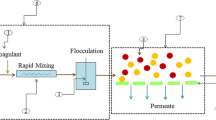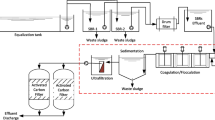Abstract
A bench-scale integrated process based on submerged aerobic powdered activated carbon-membrane bioreactor (PAC-MBR) has been utilized and established for the treatment of landfill leachate. The results showed that the submerged PAC-MBR system effectively removed biodegradable trace organic compounds by the average removal rate about 71 % at optimum food to microorganism (F/M) ratio of 0.4 gCOD/g day under a HRT of 24 h. Adding nanofiltration (NF) process increased the treatment efficiency up to 99 %. Further, adding powdered activated carbon to activated sludge (AS) resulted in a higher adsorption capacity in comparison with AS. Adsorption isotherms were investigated and fitted by the Langmuir and Freundlich isotherm models in which the Langmuir model performed better. The specific oxygen uptake rate (SOUR) showed that adding PAC reduces the effects of COD on microorganism activities. NH3–N, TKN and Heavy metals removal efficiency amounted to 97 ± 2, 96 ± 2, and 99 ± 2 %, respectively.















Similar content being viewed by others
Abbreviations
- PAC:
-
Powdered activated carbon
- MBR:
-
Membrane bioreactor
- F/M :
-
Food to microorganism
- NF:
-
Nanofiltration
- AS:
-
Activated sludge
- SOUR:
-
Specific oxygen uptake rate
- LFL:
-
Landfill leachate
- PCPs:
-
Personal care products
- BOD:
-
Biological oxygen demand
- COD:
-
Chemical oxygen demand
- SS:
-
Suspended solids
- TKN:
-
Total Kjeldahl nitrogen
- NH3–N:
-
Ammonium nitrogen
- VFAs:
-
Volatile fatty acids
- SBR:
-
Sequencing batch reactors
- UASB:
-
Upflow anaerobic sludge blanket
- CAS:
-
Conventional activated sludge
- UF:
-
Ultrafiltration
- PSf:
-
Polysulphone
- DMF:
-
N,N-Dimethylformamide
- MLVSS:
-
Mixed liquor volatile suspended solids
- MLSS:
-
Mix liquor suspended solid
- HRT:
-
Hydraulic retention time
- SVI:
-
Volumetric index of sludge
- R 2 :
-
Regression correlation coefficients
- SRT:
-
Sludge retention time
- q m :
-
Maximum adsorption capacity
- q e :
-
Amount of COD adsorbed
- C e :
-
Equilibrium concentration of the adsorbate
- K l :
-
Energy of adsorption
- K f :
-
Adsorption capacity
- n :
-
Adsorption intensity
- a :
-
Coefficient
- q :
-
Adsorption capacity
- x :
-
Function of the F/M ration
References
Ahmed FN, Lan CQ (2012) Treatment of landfill leachate using membr ane bioreactors: a review. Desalination 287:41–54
Wiszniowski J, Robert D, Surmacz-Gorska J, Miksch K, Weber JV (2006) Landfill leachate treatment methods: A review. J Environ Chem Lett 4:51–61
Renou S, Givaudan JG, Poulain S, Dirassouyan F, Moulin P (2008) Landfill leachate treatment: review and opportunity. J Hazard Mater 150:468–493
Baig S, Coulomb I, Courant P, Liechti P (1999) Treatment of landfill leachates: lapeyrouse and Satrod case studies. Ozone Sci Eng 21:1–22
Kjeldsen P, Barlaz MA, Rooker AP, Baun A, Ledin A, Christensen TH (2002) Present and long-term composition of MSW landfill leachate: a review. Crit Rev Environ Sci Technol 32:297–336
Bohdziewicz J, Kwarciak A (2008) The application of hybrid system UASB reactor-RO in landfill leachate treatment. Desalination 222:128–134
Kurniawan TA, Lo W, Chan GYS (2006) Physico–chemical treatments for removal of recalcitrant contaminants from landfill leachate. J Hazard Mater 129:80–100
Yu J, He C et al (2014) Removal of perfluorinated compounds by membrane bioreactor with powdered activated carbon (PAC): adsorption onto sludge and PAC. Desalination 334(1):23–28
Lu X, Bian X, Shi L (2002) Preparation and characterization of NF composite membrane. J Membr Sci 210:3–11
Wanga Guanghui, Fana Zheng, Wua Dexin, Qina Lei, Zhanga Guoliang, Gaoa Congjie, Mengb Qin (2014) Anoxic/aerobic granular active carbon assisted MBR integrated with nanofiltration and reverse osmosis for advanced treatment of municipal landfill leachate. Desalination 349:136–144
Ince M, Senturk E, Onkal G, Keskinler EB (2010) Further treatment of landfill leachate by nanofiltration and microfiltration—PAC. Desalination 255:52–60
Remy M, Potier V, Temmink H, Rulkensb W (2010) Why low powdered activated carbon addition reduces membrane fouling in MBRs. Water Res J 44:861–867
Satyawali Y, Balakrishnan M (2009) Effect of PAC addition on sludge properties in an MBR treating high strength wastewater. Water Res J 43:1577–1588
Tammaro Marco, Salluzzo Antonio, Perfetto Raffaele, Lancia Amedeo (2014) A comparative evaluation of biological activated carbon and activated sludge processes for the treatment of tannery wastewater. J Environ Chem Eng 2(3):1445–1455
Torretta Vincenzo, Urbini Giordano, Raboni Massimo, Copelli Sabrina, Viotti Paolo, Luciano Antonella, Mancini Giuseppe (2013) Effect of powdered activated carbon to reduce fouling in membrane bioreactors: a sustainable solution. Case study. J Sustain 5(4):1501–1509
Yinga Z, Ping G (2006) Effect of powdered activated carbon dosage on retarding membrane fouling in MBR. J Sep Purif Technol 52:154–160
Rahimpour A, Jahanshahi M, Peyravi M (2014) Development of pilot scale nanofiltration system for yeast industry wastewater treatment. J Environ Health Sci Eng 6:12–55
Peyravi M, Rahimpour A, Jahanshahi M (2012) Thin film composite membranes with modified polysulfone supports for organic solvent nanofiltration. J Membr Sci 423–424:225–237
APHA (2005) Standard methods for the examination of water and wastewater, 21st edn. American Public Health Association, Washington, DC
Standard Methods for the Examination of Water and Wastewater. American Public Health Association, Washington, DC
Kong L, Xiong Y et al (2013) Preparation and characterization of a hierarchical porous char from sewage sludge with superior adsorption capacity for toluene by a new two-step pore-fabricating process. Bioresour Technol 146:457–462
Kristensen HG, Jørgensen PE, Henze M (1992) Characterization of functional microorganism groups and substrate in activated sludge and wastewater by AUR, NUR and OUR. J Water Sci Technol 25(6):43–57
Chan YJ, Chong MF, Law CL, Hassell DG (2009) A review on anaerobic–aerobic treatment of industrial and municipal wastewater. Chem Eng J 155:1–18
Qing-Yuan H, L M, Wang C, Ji M (2015) Influence of powdered activated carbon addition on water quality, sludge properties, and microbial characteristics in the biological treatment of commingled industrial wastewater. J Hazard Mater 295:1–8
Lobos J, Wisniewski C, Heran M, Grasmick A (2008) Sequencing versus continuous membrane bioreactors: effect of substrate to biomass ratio (F/M) on process performance. J Membr Sci 317:71–77
Lobos J, Wisniewski C, Heran M, Grasmick A (2005) Effects of starvation conditions on biomass behavior for minimization of sludge production in membrane bioreactors. J Water Sci Technol 51:35
Winzeler HB, Belfort G (1993) Enhanced performance for pressure driven membrane processes: the argument for fluid instabilities. J Membr Sci 80:35–47
Wang D, Hu Q-y et al. (2015) Evaluating the removal of organic fraction of commingled chemical industrial wastewater by activated sludge process augmented with powdered activated carbon. Arab. J. Chem
Onga S-A, Toorisaka E, Hirata M, Hano T (2010) Adsorption and toxicity of heavy metals on activated sludge. Scie Asia 1513–1874:36.204
Ong SA, Lim PE, Seng CE (2003) Effects of adsorbents and copper (II) on activated sludge microorganisms and sequencing batch reactor treatment process. J Hazard Mater B103:263–277
Zhang X, Li X, Zhang Q, Peng Q, Zhang W, Gao F (2014) New insight into the biological treatment by activated sludge: the role of adsorption process. Bioresour Technol 153:160–164
HagMan M, la Cour Jansen J (2007) Oxygen uptake rate measurements for application at wastewater treatment plants. Vatten 63:131–138
Sun S, Nàcher CPI, Merkey B, Zhou Q, Xia S, Yang D et al (2010) Effective biological nitrogen removal treatment processes for domestic wastewaters with low C/N ratios: a review. J Environ Eng Sci 27:111–126
Li AJ, Li XY, Yu HQ (2011) Effect of the food-to-microorganism (F/M) ratio on the formation and size of aerobic sludge granules. Process Biochem J 46:2269–2276
Lia J, Zhaoa L, Qina L, Tiana X, Wanga A, Zhoua Y, Mengb L, Chenc Y (2016) Removal of refractory organics in nanofiltration concentrates of municipal solid waste leachate treatment plants by combined Fenton oxidative-coagulation with photo—Fenton processes. Chemosphere 146:442–449
Abdulhakeem AA, Tadkaewa N, McDonaldb JA, Khanb SJ, Pricec WE, Nghiema LD (2010) Combining MBR and NF/RO membrane filtration for the removal of trace organics in indirect potable water reuse applications. J Membr Sci 365:206–215
Kappela C, Kempermanb AJB, Temminka H, Zwijnenburga A, Rijnaartsc HHM, Nijmeijerb K (2014) Impacts of NF concentrate recirculation on membrane performance in an integrated MBR and NF membrane process for wastewater treatment. J Membr Sci 453:359–368
Barakat MA (2011) New trends in removing heavy metals from industrial wastewater. Arab J Chem 4:361–377
Al-Rashdi BAM, Johnson DJ, Hilal N (2013) Removal of heavy metal ions by nanofiltration. Desalination 315:2–17
Author information
Authors and Affiliations
Corresponding author
Rights and permissions
About this article
Cite this article
Peyravi, M., Jahanshahi, M., Alimoradi, M. et al. Old landfill leachate treatment through multistage process: membrane adsorption bioreactor and nanofitration. Bioprocess Biosyst Eng 39, 1803–1816 (2016). https://doi.org/10.1007/s00449-016-1655-0
Received:
Accepted:
Published:
Issue Date:
DOI: https://doi.org/10.1007/s00449-016-1655-0




